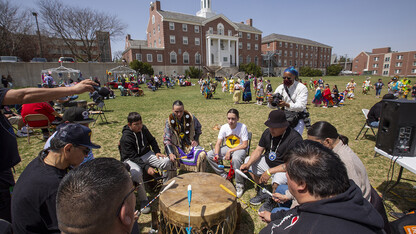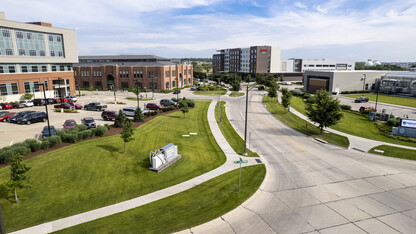· 5 min read
Husker grad’s findings may reshape human history

When archeologist Steven Holen was a student at the University of Nebraska-Lincoln in the 1970s and early 1980s, he loved to visit the mammoth fossil exhibits in the Nebraska State Museum.
He often imagined how the massive creatures might have been hunted by North America’s earliest humans.
In April, Holen, his wife Kathleen Holen, and nine other scientists, shook the archeology world with publication of research that asserts humans arrived in North America 1,000 centuries earlier than previously believed.
Holen is lead author of the article, published April 27 in Nature. In it, he described his team’s conclusions that fragments of mastodon leg bones, found at a San Diego road construction site in 1993, had been broken by humans using heavy stones as hammers and anvils. The findings were based on the patterns in which both bones and rocks were shattered, as well as the unexplained presence of a few heavy rocks in the silt deposit in which the mastodon fossils were found. Uranium-thorium dating indicated that the Cerutti Mastodon site was between 122,000 and 140,000 years old.
The beings who broke the rock could have been Homo sapiens, human relatives like Neanderthals and Denisovans, or other species, Holen said.
Holen grew up on a farm near Overton, Nebraska, near the Oregon Trail in the Platte River Valley. He often hunted rocks and bones in the Platte River and a relative’s gravel pit. He liked finding American Indian artifacts on the farm better than he did farming. He completed his bachelor’s degree in anthropology at Nebraska in 1975 and his master’s degree in 1983. Anthropology professors Dale Henning and Peter Bleed, both now retired, taught Holen excavation techniques and prehistoric technology. His master’s thesis was on stone tools found at a protohistoric Pawnee site near Schuyler, Nebraska.
Holen worked as research archeologist at the University of Nebraska State Museum from 1993 to 1999, and received his doctoral degree from the University of Kansas in 2001.
He was curator of archaeology at the Denver Museum of Nature and Science until 2013, when he retired. Holen and his wife then launched the nonprofit Center for American Paleolithic Research in Hot Springs, South Dakota.
Holen, who often studies mammoth and mastodon bones held in museum collections, was wowed when he made his first trip to San Diego to examine the mastodon fossils in 2008. Retirement allowed him to work steadily on the project.
“It took a long time to assemble all the best people, the most knowledgeable people and get things done,” he said.
The newly published findings have ignited some controversy, considering that previous archeological findings, as well as genetic studies, indicated that the ancestors of North America’s native peoples arrived after about 20,000 years ago.
“It sure has caused a stir,” Holen said. “Our critics are coming at us with both barrels. But that’s how science works.”
Skeptics say they won’t be totally convinced until other evidence of humans is found in geological deposits older than 100,000 years. They ask why no chipped-stone tools were found at the site and whether there could be some other explanation for the broken rocks and bones. They also questioned whether the land bridge at the Bering Strait would have been above water to allow human migration by foot.
Kathleen Holen said the land bridge was not inundated by water until about 125,000 years ago, which would have permitted a crossing by foot. Even if the land bridge was not available, humans were using watercraft at that time and could have made the crossing by following the coastlines of Asia and North America.
Holen said he has excavated 15 to 20 mammoth sites during his career, as many or more than any other active archeologist. In this case, like others he has observed, he believes the mastodon was already dead and its bones were scavenged to make tools or perhaps for their marrow. There is no evidence that the mastodon was hunted or butchered, which would explain the absence of chipped stone hunting or cutting tools.
Fragments of a stone hammer were scattered around a stone anvil in a way that indicates the hammer shattered when it was pounded against the anvil. He said a similar thing happened to a stone hammer he and his wife used when they conducted an experiment using rocks to break an elephant bone.
“The fracture patterns at the CM site indicate they missed the bone and hit a rock anvil and broke their hammer stone into pieces,” he said. “There were pieces of rock and fractured mastodon bone around the anvil, and the bones had impact notches and cone flakes, which are distinctive of hammer stone percussion on bone.”
Holen said archeologists rarely examine older geological deposits because they don’t expect them to contain evidence of humans. The San Diego fossils could easily have been lost if it weren’t for a sharp-eyed paleontologist named Richard Cerutti, who had enough archeology experience to recognize that something unusual had been turned up. The archaeological site was named the Cerutti Mastodon site in his honor.
“He literally saved the site for science,” Holen said.
Holen agreed that more research is needed to establish the arrival of humans in North America. He and his wife have been working to identify other potential sites and combing paleontology collections in museums in search of overlooked evidence of bone fracturing.
“What’s really been encouraging is the interest and support that younger archeologists have given us since this has been published,” he said. “We need a lot of people looking into these older deposits. We have no idea whether this early population survived. But if we don’t look, we can’t find it.”









